
A tea bag, or the compound teabag, is a small, porous, sealed bag or packet, typically containing tea leaves or the leaves of other herbs, which is immersed in water to steep and make an infusion. Originally used only for tea, they are now made with other tisanes as well.
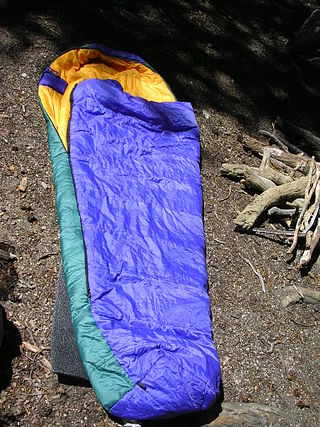
A sleeping bag is an insulated covering for a person, essentially a lightweight quilt that can be closed with a zipper or similar means to form a tube, which functions as lightweight, portable bedding in situations where a person is sleeping outdoors. It is also commonly used indoors for people who do not have beds or at sleepovers for when one or more persons cannot all fit in the bed or do not feel comfortable sleeping with someone. Its primary purpose is to provide warmth and thermal insulation through its synthetic or down insulation. It also typically has a water-resistant or water-repellent cover that protects, to some extent, against wind chill and light precipitation, but a tent is usually used in addition to a sleeping bag, as it performs those functions better. The bottom surface also provides some cushioning, but a sleeping pad or camp cot is usually used in addition for that purpose. The bottom surface of a sleeping bag may be moderately water repellent, but a plastic tarp or groundsheet is often used to protect against moist ground.
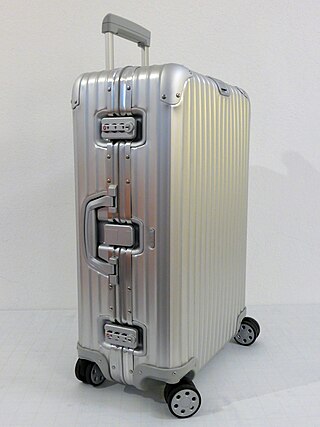
Baggage or luggage consists of bags, cases, and containers which hold a traveler's personal articles while the traveler is in transit. A modern traveler can be expected to have packages containing clothing, toiletries, small possessions, trip necessities. On the return trip, travelers may have souvenirs and gifts. For some people, luggage and the style thereof is representative of the owner's wealth and status. Luggage is constructed to protect the items during travel either with a hard shell or a durable soft material. Luggage often has internal subdivisions or sections to aid in securing items. Handles are typically provided to facilitate carrying, and some luggage may have wheels and/or telescoping handles or leashes to make moving them easier.

A handbag, commonly known as a purse or pocketbook in North American English, is a handled medium-to-large bag used to carry personal items.

A body bag, also known as a cadaver pouch or human remains pouch (HRP), is a non-porous bag designed to contain a human body, used for the storage and transportation of shrouded corpses.

Plastic shopping bags, carrier bags, or plastic grocery bags are a type of plastic bag used as shopping bags and made from various kinds of plastic. In use by consumers worldwide since the 1960s, these bags are sometimes called single-use bags, referring to carrying items from a store to a home. However, it is rare for bags to be worn out after single use and in the past some retailers incentivised customers to reuse 'single use' bags by offering loyalty points to those doing so. Even after they are no longer used for shopping reuse for storage or trash is common, and modern plastic shopping bags are increasingly recyclable or compostable. In recent decades, numerous countries have introduced legislation restricting the sale of plastic bags, in a bid to reduce littering and plastic pollution.
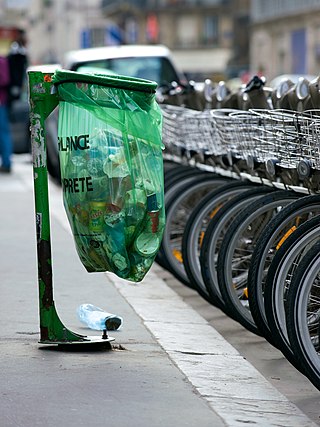
A plastic bag, poly bag, or pouch is a type of container made of thin, flexible, plastic film, nonwoven fabric, or plastic textile. Plastic bags are used for containing and transporting goods such as foods, produce, powders, ice, magazines, chemicals, and waste. It is a common form of packaging.

A paper bag is a bag made of paper, usually kraft paper. Paper bags can be made either with virgin or recycled fibres to meet customers’ demands. Paper bags are commonly used as shopping carrier bags and for packaging of some consumer goods. They carry a wide range of products from groceries, glass bottles, clothing, books, toiletries, electronics and various other goods and can also function as means of transport in day-to-day activities.

Hessian, burlap in the United States and Canada, or crocus in Jamaica and the wider Caribbean, is a woven fabric usually made from skin of the jute plant or sisal fibres, which may be combined with other vegetable fibres to make rope, nets, and similar products. Gunny is similar in texture and construction.

A messenger bag is a type of sack, usually made of cloth. It is worn over one shoulder with a strap that goes across the chest resting the bag on the lower back. While messenger bags are sometimes used by couriers, they are now also an urban fashion icon. Some types of messenger bags are called carryalls. A smaller version is often called a sling bag.
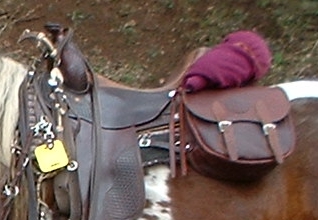
Saddlebags are bags that are attached to saddles.
A Nomadic bag is a bag woven by various nomadic tribes of the Middle East and Central Asia for utilitarian and decorative purposes.
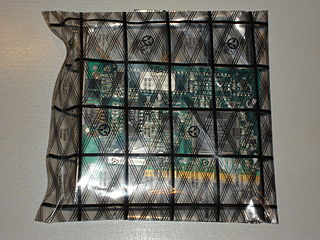
An antistatic bag is a bag used for storing electronic components, which are prone to damage caused by electrostatic discharge (ESD).
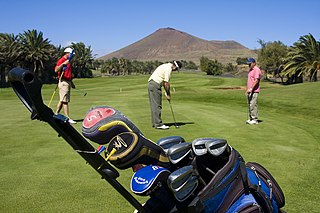
Golf equipment encompasses the various items that are used to play the sport of golf. Types of equipment include the golf ball, golf clubs, and devices that aid in the sport.
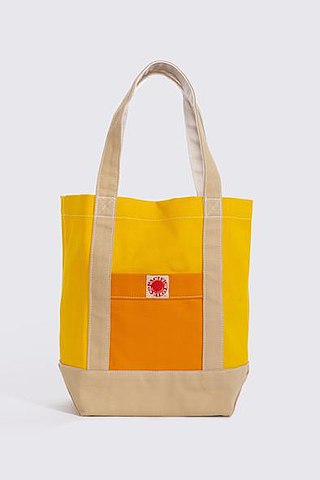
A tote bag is a large and often unfastened bag with parallel handles that emerge from the sides of its pouch.

A bean bag is a sealed bag containing dried beans, PVC pellets, expanded polystyrene, or expanded polypropylene. The bags are commonly used for throwing games, but they have various other applications.

A string bag, net bag, or mesh bag is an open netted bag. Mesh bags are constructed from strands, yarns, or non-woven synthetic material into a net-like structure. String bags are used as reusable shopping bags and as packaging for produce.

A bag is a common tool in the form of a non-rigid container. The use of bags predates recorded history, with the earliest bags being lengths of animal skin, cotton, or woven plant fibers, folded up at the edges and secured in that shape with strings of the same material.

A security bag is a heavy duty bag used to contain high-value products or documents or legally sensitive items. Envelopes with security features are called security envelopes as well as security bags. Cash for deposit in a bank is often placed in a special deposit bag with security features. When used to contain items related to a crime, special evidence bags are used. Authentication of signatures and chain of custody are often required.
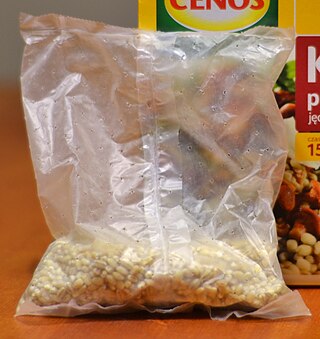
Boil-in-bags are a form of packaged food products in which bagged food is heated or cooked in boiling water. Plastic bags can be solid and impermeable for holding frozen foods; alternatively, bags can be porous or perforated to allow boiling water into the bag.


















